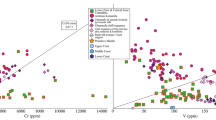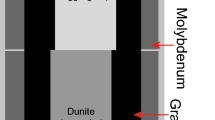Abstract
We have investigated melting relations in the Fe–O–S ternary system in the pressure range of 15–27 GPa and 1873 K. Subsolidus phase relations are Fe, Fe3S2, and FeO up to 17 GPa and Fe, Fe3S, and FeO above this pressure. The eutectic temperature slightly decreases from ambient pressure to 17 GPa, whereas increases above this pressure. The eutectic temperature in this study is 100 K lower than that in the Fe–S binary system. The oxygen content in the Fe–O–S eutectic liquid drops when the coexisting solid phases changes from FeS to Fe3S2. The cotectic lines in the ternary phase diagram lie close to the Fe–FeS binary axis. The isothermal sections indicate that oxygen solubility in the Fe–O–S liquid increases with increasing temperature, and with increasing sulfur content. The solubility of sulfur in the solid Fe has a maximum value at the eutectic temperature, and decreases with increasing temperature. Our results could have important implications for formation and composition of the Martian core.





Similar content being viewed by others
References
Allegre CA, Manhes G, Lewin E (2001) Chemical composition of the earth and the volatitily control on planetary genetics. Earth Planet Sci Lett 185:49–69. doi:10.1016/S0012-821X(00)00359-9
Balog PS, Secco RA, Rubie DC, Frost DJ (2003) Equation of state of liquid Fe-10 wt.% S: implications for the metallic cores of planetary bodies. J Geophys Res 108(B2):2124. doi:10.1029/2001JB001646
Bertka CM, Fei Y (1998) Density profile of an SNC model martian interior and the moment-of inertia factor of Mars. Earth Planet Sci Lett 157:79–88. doi:10.1016/S0012-821X(98)00030-2
Boehler R (1996) Fe–FeS eutectic temperatures to 629 kbar. Phys Earth Planet Inter 96:181–186. doi:10.1016/0031-9201(96)03150-0
Campbell AJ, Seagle CT, Heinz DL, Shen G, Prakapenka VB (2007) Partial melting in the iron–sulfur system at high pressure: a synchrotron X-ray diffraction study. Phys Earth Planet Inter 162:119–128. doi:10.1016/j.pepi.2007.04.001
Chudinovskikh L, Boehler R (2007) Eutectic melting in the system Fe–S to 44 GPa. Earth Planet Sci Lett 257:97–103. doi:10.1016/j.epsl.2007.02.024
Dreibus G, Palme H (1996) Cosmochemical constraints on the sulfur content in the earth’s core. Geochem Cosmochem Acta 60:1125–1130. doi:10.1016/0016-7037(96)00028-2
Dreibus G, Wänke H (1985) Mars, a volatile-rich planet. Meteoritics 20:367–381
Fei Y, Bertka C (2005) The interior of Mars. Science 308:1120–1121. doi:10.1126/science.1110531
Fei Y, Bertka CM, Finger LW (1997) High-pressure iron-sulfur compounds Fe3S2, and melting relations in the system Fe–FeS. Science 275:1621–1623. doi:10.1126/science.275.5306.1621
Fei Y, Bertla CM, Prewitt CT (2000) Structure type and bulk modulus of Fe3S, a new iron-sulfur compound. Am Mineral 85:1830–1833
Fei Y, Van Orman J, Li J, van Westrenen W, Sanloup C, Minarik W, Hirose K, Komabayashi T, Walter M, Funakoshi K (2004) Experimentally determined postspinel transformation boundary in Mg2SiO4 using MgO as an internal pressure standard and its geophysical implications. J Geophys Res 109:B02305–8. doi:1029/2003JB002562
Hauck S, Phillips RF (2002) Thermal and crustal evolution of Mars. J Geophys Res 107:E7, 5052. doi:10.1029/2001JE001801
Helffrich G, Kaneshima S (2004) Seismological constraints on core composition from Fe–O–S liquid immiscibility. Science 306:2239–2242. doi:10.1126/science.1101109
Hillgren VJ, Gessmann CK, Li J (2000) An experimental perspective on the light elements in the earth’s core. University of Arizona Press, Tuscon 29:245–263
Hirose K, Fei Y, Ono S, Yagi T, Funakoshi K (2001) In situ measurements of the phase transition boundary in Mg3Al2Si3O12: implications for the nature of the seismic discontinuities in the Earth’s mantle. Earth Planet Sci Lett 184:567–573. doi:10.1016/S0012-821X(00)00354-X
Jephcoat A, Olson P (1987) Is the inner core of the earth pure iron? Nature 325:332–335. doi:10.1038/325332a0
Kato T, Ringwood AE (1989) Melting relationships in the system Fe–FeO at high pressures: implication for the composition and formation of the earth’s core. Phys Chem Miner 16:524–538. doi:10.1007/BF00202207
Kawazoe T, Ohtani E (2006) Reaction between liquid iron and (Mg, Fe) SiO3-perovskite and solubilities of Si and O in molten iron at 27 GPa. Phys Chem Miner 33:227–234. doi:10.1007/s00269-006-0071-4
Kondo T, Ohtani E, Hirao N, Yagi T, Kikegawa T (2004) Phase transitions of (Mg, Fe)O at megabar pressures. Phys Earth Planet Inter 143/144:201–213. doi:10.1016/j.pepi.2003.10.008
Kubaschewski O (1982) Iron–binary phase diagram. Springer-Verlag, New York, pp 125–128
Li J, Fei Y (2003) Experimental constraints on core composition, in treatise on geochemistry. In: Carlson RW (ed) vol. 2, pp 521–546, Elsevier, New York
Li J, Fei Y, Mao HK, Hirose K, Shieh SR (2001) Sulfur in the earth’s inner core. Earth Planet Sci Lett 193:509–514. doi:10.1016/S0012-821X(01)00521-0
Litasov KD, Ohtani E (2005) Phase relations in hydrous MORB at 18–28 GPa: implications for heterogeneity of the lower mantle. Phys Earth Planet Inter 150:239–263. doi:10.1016/j.pepi.2004.10.010
Lodders K, Fegley B (1997) An oxygen isotope model for the composition of Mars. Icarus 126:373–394. doi:10.1006/icar.1996.5653
Longhi J, Knittle E, Holloway J, Wänke H (1992) The bulk composition, mineralogy, and internal structure of Mars. In: Kieffer HH, Jakosky BM, Snyder CW, Matthews MS (eds) Mars. University of Arizona Press, Tuscon, pp 184–208
McCammon CA, Liu LG (1984) The effects of pressure and temperature on nonstoichiometric wüstite, Fe x O: the iron–rich phase boundary. Phys Chem Miner 10:106–113. doi:10.1007/BF00309644
McDonough WF (2003) Compositional model for the earth’s core, in mantle and core, vol 2, treatise on geochemistry. Elsevier, New York, pp 547–568
Morishima H, Kato T, Suto M, Ohtani E, Urakawa S, Utsumi W et al (1994) The phase boundary between α- and β-Mg2SiO4 determined by in X-ray observation. Science 265:1202–1203. doi:10.1126/science.265.5176.1202
Murakami M, Hirose K, Ono S, Tsuchiya T, Isshiki M, Watanuki T (2004) High pressure and high temperature phase transitions of FeO. Phys Earth Planet Inter 143/144:273–282. doi:10.1016/j.pepi.2003.06.011
Murthy RA, Hall HT (1970) The chemical composition of the earth’s core: possibility of sulphur in the core. Phys Earth Planet Inter 2:276–282. doi:10.1016/0031-9201(70)90014-2
Murthy RA, Hall HT (1972) The origin and chemical composition of the earth’s core. Phys Earth Planet Inter 6:123–130. doi:10.1016/0031-9201(72)90043-X
Naldrett AJ (1969) A portion of the system Fe–S–O between 900 and 1,080°C and its application to sulfide ore magmas. J Petrol 10:171–201
Ohtani E, Kamaya N (1992) The geochemical model of Mars. Geophys Res Lett 19:2239–2242. doi:10.1029/92GL02369
Ohtani E, Ringwood AE, Hibberson W (1984) Composition of the core II. Effect of high pressure on solubility of FeO in molten iron. Earth Planet Sci Lett 71:94–103. doi:10.1016/0012-821X(84)90055-4
Poirier JP (1994) Light elements in the earth’s outer core: a critical review. Phys Earth Planet Inter 85:319–337. doi:10.1016/0031-9201(94)90120-1
Ringwood AE (1977) Composition of the core and implications for origin of the earth. Geochem J 11:111–135
Ringwood AE, Hibberson W (1990) The system Fe–FeO revisited. Phys Chem Miner 17:313–319. doi:10.1007/BF00200126
Sanloup C, Guyot F, Gillet P, Fiquet G, Mezouar M, Martinez I (2000) Density measurements of liquid Fe–S alloys at high-pressure. Geophys Res Lett 27:811–814. doi:10.1029/1999GL008431
Sanloup C, Jambon A, Gillet P (1999) A simple chondritic model of Mars. Phys Earth Planet Inter 112:43–54. doi:10.1016/S0031-9201(98)00175-7
Sohl F, Spohn T (1997) The interior structure of Mars: implications from SNC meteorites. J Geophys Res 102:1613–1635. doi:10.1029/96JE03419
Stevenson DJ (2001) Mars’ core and magnetism. Nature 412:214–219. doi:10.1038/35084155
Stewart AJ, Schmidt MW, van Westrenen W, Libske C (2007) Mars: a new core-crystallization regime. Science 316:1323–1325. doi:10.1126/science.1140549
Suzuki A, Ohtani E, Morishima H, Kubo T, Kanbe Y, Kondo T et al (2000) In situ determination of the phase boundary between wadsleyite and ringwoodite in Mg2SiO4. Geophys Res Lett 27:803–806. doi:10.1029/1999GL008425
Terasaki H, Frost DJ, Rubie DC, Langenhorst F (2005) The effect of oxygen and sulphur on the dihedral angle between Fe–O–S melt and silicate minerals at high pressure: implications for Martian core formation. Earth Planet Sci Lett 232:379–392. doi:10.1016/j.epsl.2005.01.030
Tsuno K, Ohtani E, Terasaki H (2007a) Immiscible two-liquid regions in the Fe–O–S system at high pressure: implications for planetary cores. Phys Earth Planet Inter 160:75–85. doi:10.1016/j.pepi.2006.09.004
Tsuno K, Terasaki H, Ohtani E, Suzuki A, Asahara Y, Nishida K, Sakamaki T, Funakoshi K, Kikegawa T (2007b) In situ observation and determination of liquid immiscibility in the Fe–O–S melt at 3 GPa using a synchrotron X-ray radiographic technique. Geophys Res Lett 34:L17303, doi:10/2007GL03750
Urakawa S, Kato M, Kumazawa M (1987) Experimental study on the phase relations in the system Fe–Ni–O–S up to 15 GPa. In: Manghnami MH, Shono Y (eds) High pressure research in mineral physics. Terrapub/AGU, pp 95–111
Urakawa S, Someya K, Terasaki H, Katsura T, Yokoshi S, Funakoshi K et al (2004) Phase relationships and equations of state for FeS at high pressures and temperatures and implications for the internal structure of Mars. Phys Earth Planet Inter 143/144:469–479. doi:10.1016/j.pepi.2003.12.015
Usselman TM (1975) Experimental approach to the state of the core: part I. The liquidus relations of the Fe0 rich portion of the Fe–Ni–S system from 30 to 100 kb. Am J Sci 275:278–290
Wade J, Wood BJ (2005) Core formation and the oxidation state of the earth. Earth Planet Sci Lett 236:78–95. doi:10.1016/j.epsl.2005.05.017
Williams Q, Jeanloz R (1990) Melting relations in the iron-sulfur system at ultra-high pressures: implications for the thermal state of the earth. J Geophys Res 95:19299–19310. doi:10.1029/JB095iB12p19299
Williams JP, Nimmo F (2004) Thermal evolution of the Martian core: implications for an early dynamo. Geology 32:97–100. doi:10.1130/G19975.1
Yoder CF, Konopliv AS, Yuan DN, Standish EM, Folkner WM (2003) Fluid core size of Mars from detection of the solar tide. Science 300:299–303. doi:10.1126/science.1079645
Acknowledgments
We thank Y. Ito for the electron microprobe analysis of run products. Comments from S. Urakawa and an anonymous reviewer helped to improve the manuscript. This work was supported by the Grant-in-Aid of the Scientific Research (S) of the Ministry of Education, Culture, Science, Sport, and Technology of the Japanese Government (No. 14102009) to E.O., and conducted as a part of the 21st Century Center-of-Excellence program ‘Advanced Science and Technology Center for the Dynamic Earth’.
Author information
Authors and Affiliations
Corresponding author
Rights and permissions
About this article
Cite this article
Tsuno, K., Ohtani, E. Eutectic temperatures and melting relations in the Fe–O–S system at high pressures and temperatures. Phys Chem Minerals 36, 9–17 (2009). https://doi.org/10.1007/s00269-008-0254-2
Received:
Accepted:
Published:
Issue Date:
DOI: https://doi.org/10.1007/s00269-008-0254-2




